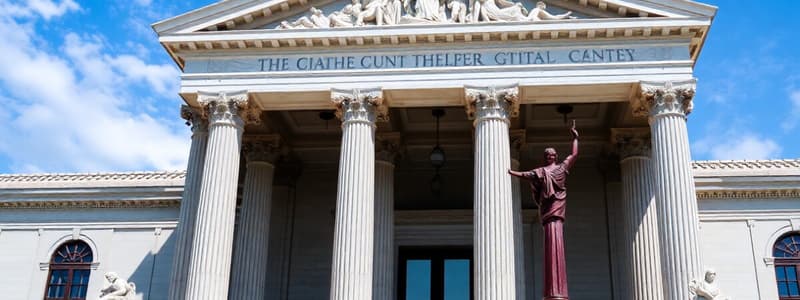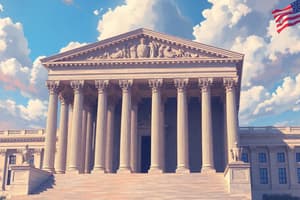Podcast
Questions and Answers
According to Article III of the U.S. Constitution, what role does Congress play in the federal judiciary?
According to Article III of the U.S. Constitution, what role does Congress play in the federal judiciary?
- Congress can overrule decisions made by the Supreme Court.
- Congress directly appoints Supreme Court justices. (correct)
- Congress sets up lower courts within the federal judiciary.
- Congress determines the types of cases federal courts can hear.
How does the U.S. Constitution protect federal judges from political pressures?
How does the U.S. Constitution protect federal judges from political pressures?
- By granting judges the power to issue advisory opinions, influencing public policy.
- By allowing judges to serve fixed terms that coincide with presidential terms. (correct)
- By requiring all judicial appointments to be approved by a bipartisan congressional committee.
- By ensuring judges receive secure compensation and hold their positions during good behavior.
What is the significance of Judicial Review in the U.S. legal system?
What is the significance of Judicial Review in the U.S. legal system?
- It enables the judiciary to determine if actions of other government branches are unconstitutional.
- It grants state courts the final say in interpreting federal laws. (correct)
- It requires all federal court decisions to be ratified by Congress.
- It allows the Supreme Court to directly create new federal laws.
In the context of the U.S. dual court system, what distinguishes federal courts from state courts?
In the context of the U.S. dual court system, what distinguishes federal courts from state courts?
What is the role of precedents in the U.S. court system?
What is the role of precedents in the U.S. court system?
What is the primary function of the U.S. Federal District Courts?
What is the primary function of the U.S. Federal District Courts?
In criminal cases within Federal District Courts, who represents the government?
In criminal cases within Federal District Courts, who represents the government?
What is the main role of Circuit Courts of Appeals in the federal court system?
What is the main role of Circuit Courts of Appeals in the federal court system?
What does an en banc review by a Circuit Court of Appeals entail?
What does an en banc review by a Circuit Court of Appeals entail?
What is the purpose of a writ of certiorari in the context of appealing to the U.S. Supreme Court?
What is the purpose of a writ of certiorari in the context of appealing to the U.S. Supreme Court?
What are Amicus Curiae briefs, and why are they submitted to the Supreme Court?
What are Amicus Curiae briefs, and why are they submitted to the Supreme Court?
How much time is generally allotted for each party to present oral arguments before the U.S. Supreme Court?
How much time is generally allotted for each party to present oral arguments before the U.S. Supreme Court?
What occurs if the Supreme Court justices reach a tie vote on a case?
What occurs if the Supreme Court justices reach a tie vote on a case?
What is the 'majority opinion' of the Supreme Court?
What is the 'majority opinion' of the Supreme Court?
What role does the American Bar Association (ABA) play in the selection of federal judges?
What role does the American Bar Association (ABA) play in the selection of federal judges?
What characterises 'Originalists' in the context of judicial philosophy?
What characterises 'Originalists' in the context of judicial philosophy?
What is the 'nuclear option' in the context of Senate confirmations, and why was it used regarding judicial appointments?
What is the 'nuclear option' in the context of Senate confirmations, and why was it used regarding judicial appointments?
How is the number of justices on the Supreme Court determined?
How is the number of justices on the Supreme Court determined?
Which of the following is true regarding the U.S. Constitution and requirements for federal judges?
Which of the following is true regarding the U.S. Constitution and requirements for federal judges?
Flashcards
What does Article III do?
What does Article III do?
Creates the federal judiciary, including the Supreme Court.
What is Judicial Review?
What is Judicial Review?
The power to determine if actions by other branches of government are unconstitutional.
What is the Dual Court System?
What is the Dual Court System?
A system with separate federal and state courts, where the Supreme Court is the final court of appeal.
What are Precedents?
What are Precedents?
Signup and view all the flashcards
What do Federal District Courts do?
What do Federal District Courts do?
Signup and view all the flashcards
Who is the U.S. Attorney?
Who is the U.S. Attorney?
Signup and view all the flashcards
What do Circuit Courts of Appeals do?
What do Circuit Courts of Appeals do?
Signup and view all the flashcards
What are Writs of Certiorari?
What are Writs of Certiorari?
Signup and view all the flashcards
What are Amicus Curiae Briefs?
What are Amicus Curiae Briefs?
Signup and view all the flashcards
Who is the Solicitor General?
Who is the Solicitor General?
Signup and view all the flashcards
What is a Majority Opinion?
What is a Majority Opinion?
Signup and view all the flashcards
What is a Concurring Opinion?
What is a Concurring Opinion?
Signup and view all the flashcards
What is a Dissenting Opinion?
What is a Dissenting Opinion?
Signup and view all the flashcards
What does the American Bar Association do?
What does the American Bar Association do?
Signup and view all the flashcards
Who are Originalists?
Who are Originalists?
Signup and view all the flashcards
Who are Living Constitutionalists?
Who are Living Constitutionalists?
Signup and view all the flashcards
Study Notes
- Federal courts are the topic of discussion
The Constitution and the Judiciary
- Article III creates the federal judiciary, including the Supreme Court.
- Lower courts are set up by Congress.
- Federal courts preside over cases arising under the Constitution, federal laws, treaties, and disputes between states.
- Judges maintain their positions during good behavior and receive consistent compensation, insulating them from political influences.
- Courts address only actual disputes, avoiding advisory opinions.
The Power of Judicial Review
- Judicial Review is the power to determine if actions taken by the other branches of government and states are unconstitutional, rendering the action null and void.
- In 1803, the Supreme Court assumed the power of Judicial Review, extending it to all lower federal and state courts.
The U.S. Court System
- Before the Constitution, only state courts were established.
- The U.S. has separate federal and state courts.
- The Supreme Court is the final court of appeal in all cases.
- The U.S. court system operates as a hierarchy.
- Losing parties can appeal their cases to higher courts: first to the circuit courts, then to the Supreme Court if the justices agree.
- Guidelines from earlier cases are Precedents, from the Supreme Court, shaping court operations.
Federal District Courts
- Federal District Courts are the entry point for cases involving federal laws, the Constitution, Congress, or other federal issues in criminal and civil matters.
- There are 94 U.S. Federal District Courts.
- Every state has between 1 and 4 districts.
- Evidence is presented, and witnesses are questioned by both sides.
- The government is represented by a U.S. Attorney, appointed by the President with Senate approval, in criminal cases.
- Juries decide the final verdict in cases.
Circuit Courts of Appeals
- Circuit Courts review appeals from federal district courts.
- They focus on legal reasoning, not re-examining facts.
- Cases are heard in the circuit where the district court hearing occurred.
- Lawyers use briefs and oral arguments without new evidence or witnesses.
- A rotating panel of 3 judges makes the decision.
- An en banc review, where all judges participate, adds credibility.
- These courts are arranged in 12 circuits, with a 13th circuit court specializing in cases like patents and copyrights.
The U.S. Supreme Court
- U.S. Supreme Court cases come from either circuit courts (U.S. Courts of Appeals) or state supreme courts.
- To appeal to the Supreme Court, the petitioner petitions for writs of certiorari, an order calling up lower court records for review.
- The Supreme Court hears fewer than 100 cases a year, or fewer than 2% of petitions.
- The Rule of Four requires 4 out of 9 justices to agree to hear a case.
- Accepted cases are placed on the docket, and each party submits written arguments known as briefs.
- Those not party to the case can submit briefs called Amicus Curiae briefs to advocate for one side.
- Oral arguments last an hour per party, with 30 minutes allocated for each party to speak and answer questions from the Justices.
- Oral arguments are public, but cameras are prohibited.
- The Solicitor General argues the government's position when the United States is a party.
- Justices discuss the case in a closed conference and take an initial vote.
- A tie vote means the lower court's decision stands.
- The reasoning is formalized as the majority opinion if more than half the justices agree.
- Justices who agree with the majority but for a different reason may write a concurring opinion.
- Justices disagreeing with the majority may write a dissenting opinion.
The Selection of Federal Judges/Justices
- Federal judges and Supreme Court Justices are nominated by the president and must be confirmed by a Senate majority.
- Presidents typically consult a list maintained by the American Bar Association for recommendations.
- There are no requirements for federal judges.
- The Senate Judiciary Committee conducts interviews with nominees before Senate votes.
Senate Confirmation
- Before the Senate votes, the Senate Judiciary Committee conducts extensive, multi-day interviews with the nominee.
- Senators ask thorough questions to assess the nominee's judicial views.
- Originalists favor justices who interpret the Constitution strictly, limiting federal power, and protecting states' rights.
- Living Constitutionalists prefer flexible interpretations to adapt the federal government to changing times.
Contentious Confirmations
- March 2016: President Obama nominated Merrick Garland to replace Justice Scalia, but Senate Majority Leader Mitch McConnell withheld hearings.
- McConnell's strategy resulted in Neil Gorsuch's confirmation in 2017 after Trump's inauguration.
- Republicans used the "nuclear option" to prevent Democrats from filibustering Gorsuch's approval.
- 2018: Trump appointed Brett Kavanaugh, confirmed amid allegations of assault from Christine Blasey Ford.
The Current Supreme Court
- Congress determines the number of Supreme Court justices.
- The original court in 1789 had 6 justices.
- Has been 9 since 1869.
- Current Chief Justice: John G. Roberts
- Current Associate Justices: Clarence Thomas, Samuel A. Alito, Sonia Sotomayor, Elena Kagan, Neil M. Gorsuch, Brett M. Kavanaugh, Amy Coney Barrett, and Ketanji Brown Jackson
Studying That Suits You
Use AI to generate personalized quizzes and flashcards to suit your learning preferences.




